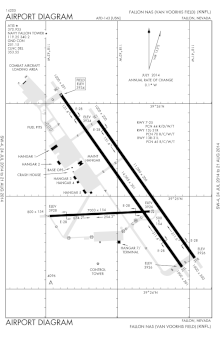Naval Air Station Fallon
| Naval Air Station Fallon | |||||||||||
|---|---|---|---|---|---|---|---|---|---|---|---|
Van Voorhis Field | |||||||||||
| Near AMSL | |||||||||||
| |||||||||||
| Source: Combat Search and Rescue (CSAR) training also takes place there.
The airfield is named Van Voorhis Field in honor of Commander Bruce Van Voorhis (1908–1943) who was awarded a posthumous Medal of Honor. HistoryThe airfield at NAS Fallon was originally built in 1942 as part of a defensive network to repel a feared Japanese invasion of the west coast. It was soon taken over by the Navy for training use and has been used as such ever since with the exception of the period of 1946 to 1951, during which it was used by the Bureau of Indian Affairs. During the years prior to 1972, the base was known as Naval Auxiliary Air Station and was heavily used during the Vietnam War by various squadrons that rotated through the base before deploying to carriers headed for Vietnam. During these same years prior to 1972, many ground troops were temporarily assigned to NAAS Fallon for their hot weather training (during the summer months) and cold weather training (during the winter months). On 1 January 1972, the Navy recognized NAS Fallon's importance to naval aviation by upgrading the base from auxiliary air station status to a major aviation command as a full-fledged naval air station. While NAS Fallon provides training for visiting carrier air wings, Strike Fighter Squadron 127 (VFA-127 ), the "Desert Bogeys", was the air station's only permanently based squadron from October 1987 until it was disestablished on 23 March 1996.
 The Navy relocated its Naval Strike and Air Warfare Center (NSAWC), was established on 11 July 1996 and was a unification of TOPGUN, Strike University (Strike U), the Naval Strike Warfare Center, and TOPDOME, the Carrier Airborne Early Warning Weapons School. In addition to transferring the NSAWC squadron, a Navy Reserve adversary squadron, Fighter Squadron Composite THIRTEEN (VFC-13), the "Saints," was also permanently relocated from its former base at NAS Miramar to NAS Fallon. As a result, VFC-13 replaced the disestablished VFA-127 in the fighter adversary role.
Associated bombing ranges checker the surrounding armored vehicles, including some exotics, have been scattered throughout the area, presumably for ambiance. Most of this area is publicly accessible, with the exception of areas immediately surrounding the radar installations. The entire training area surrounding NAS Fallon is known as the Fallon Range Training Complex (FRTC).[2][3]
USAF Radar StationBetween 1956 and 1975, the AN/FPS-3 search set briefly saw service in 1959.
 During 1962 Fallon AFS joined the AN/FPS-6 height-finder radar was added.
In addition to the main facility at NAS Fallon, the squadron also operated a remote AN/FPS-14 Gap Filler site:
Around 1965, Fallon became an AN/FPS-66 A.
Over the years, the equipment at the station was upgraded or modified to improve the efficiency and accuracy of the information gathered by the radars. The 858th Radar Sq was inactivated and replaced by the 858th Air Defense Group in March 1970. MuseumThe navy maintains the Naval Air Station Fallon Air Park museum on the base.[8] Search and rescue teamSince 1972 the base has had its own search and rescue team. Originally named Desert Angels and later renamed Longhorns, the team's mission is to provide SAR support for visiting Carrier Air Groups and other NAS Fallon tenant commands. The Longhorns flew the Bell UH-1N from 1972 to 2009 and the Sikorsky SH-60F from 2009 to 2011.[citation needed] The team currently flies the Sikorsky MH-60S.[9] The Longhorns frequently support civilian search, rescue and medical evacuation efforts in conjunction with local law enforcement, medical and search and rescue agencies.[citation needed] Gallery
See alsoReferencesNotes
Bibliography
Further reading
External links
| |||||||||||



